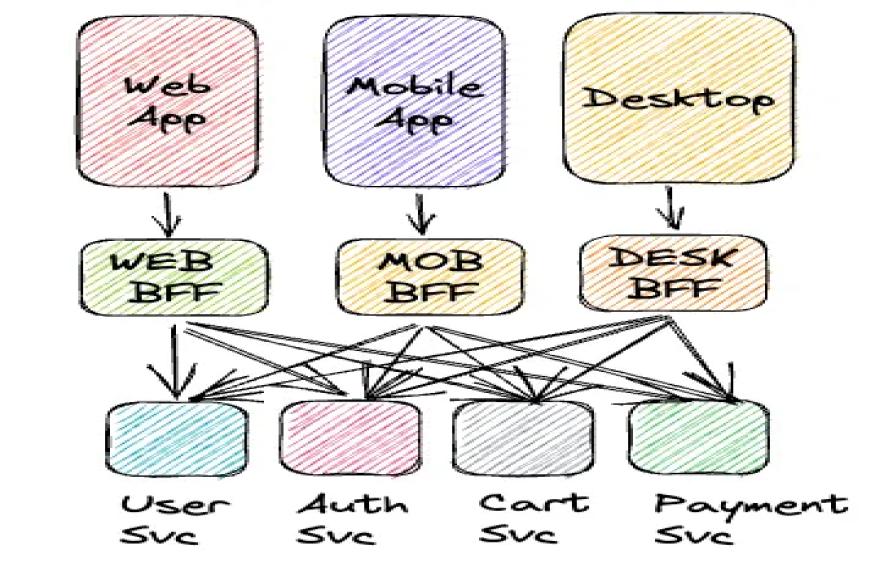As software development advances, the popularity of microservices and cloud-native architectures, along with an increasing number of client devices like mobile apps, web platforms, and IoT gadgets, has led to new architectural approaches. One standout solution is the Backend for Frontend (BFF) architecture, which has proven essential in creating efficient, maintainable, and secure applications by tailoring backend services to each client’s unique needs.
Understanding Backend for Frontend (BFF) Architecture
Backend for Frontend is a specialized architecture pattern that introduces a dedicated backend layer for each type of frontend interface, such as mobile apps, web applications, or IoT devices. Unlike using a single backend API to handle all client requests, the BFF model allows each frontend to have its own dedicated backend that:
- Aggregates data from multiple sources,
- Formats data according to client requirements, and
- Manages client-specific logic.
This structure allows for a separation of concerns, making it easier to optimize each backend according to the needs of specific user experiences.
How BFF Operates
The operation of a BFF can be broken down into the following steps:
- Client Request: Each client (e.g., mobile, web) communicates with its own BFF layer.
- BFF Layer: This layer consolidates and processes data from various microservices, formats the response, and sends it back to the client.
- Microservices Interaction: The BFF layer interacts with the backend services (e.g., user data, order details) and orchestrates them as needed.
Comparing Traditional Architectures with BFF
In traditional setups, a single API gateway often manages requests across different devices. While this approach provides basic routing, authentication, and rate limiting, it lacks the flexibility to address the specific requirements of different frontends. For example:
- Clients may require tailored data models,
- Mobile applications may need optimization for slower networks, and
- Complex orchestration across services may be necessary to meet the frontend’s specific needs.
Traditional architectures often lead to issues like over-fetching (excess data retrieval) or under-fetching (insufficient data), requiring clients to make additional calls. BFF resolves these issues by separating backends for each frontend, ensuring clients get precisely the data they need.
Why BFF Shines in Modern Architecture
Several key benefits set BFF apart in backend architecture:
- Customized User Experiences: Each frontend gets a customized response, ensuring an optimal user experience for mobile, desktop, and IoT devices.
- Simplified Structure: BFFs are tailored for each client type, simplifying application design and maintenance.
- Boosted Performance: BFFs reduce the need for unnecessary API calls, leading to quicker responses and improved user satisfaction.
- Accelerated Development: Teams can work on separate BFFs for each frontend, speeding up development and reducing conflicts.
- Enhanced Security: BFFs can implement strict security protocols like token validation and input checks, bolstering the security of backend services.
When Should You Use BFF?
BFF architecture is especially useful in scenarios such as:
- Multi-Platform Applications: For multi-platform apps (web, mobile, IoT), BFF enables a tailored experience for each platform.
- Microservice Orchestration: In microservice architectures, where data from multiple services needs to be aggregated, BFF can unify these services and present a streamlined response.
- Modernizing Legacy APIs: When transitioning to microservices, BFF can abstract the complexities of the backend by offering a consistent frontend interface while integrating with legacy systems.
Challenges to Consider
Although BFF architecture offers numerous advantages, there are also challenges:
- Increased Maintenance: Managing multiple BFFs for different frontends increases complexity and requires careful monitoring, scaling, and security.
- Data Consistency: Without careful design, inconsistencies may arise between the data returned across different BFFs.
- Performance Bottlenecks: If a BFF layer is not well-optimized, it may become a bottleneck for high volumes of requests.
Best Practices for Implementing BFF Architecture
Here are some key strategies for successful BFF implementation:
- Limit Business Logic in the BFF: Focus on data formatting and orchestration rather than embedding complex business logic.
- Utilize Caching: Caching can improve performance, especially for mobile clients.
- Centralize Error Handling: Managing error handling and logging at the BFF level minimizes client-facing issues.
- Ensure Security: Implement robust security practices like authentication, authorization, and rate limiting to safeguard backend services.
Real-World Success Stories with BFF
- Netflix: Netflix leverages BFF architecture to create a seamless, cross-device experience. Their mobile app retrieves only essential data, while the desktop app fetches more detailed information.
- Spotify: Spotify’s BFF ensures optimized data delivery across various devices, whether on a phone, tablet, or smart speaker, for smooth and fast music streaming.
Conclusion: Why BFF is Key for Modern Applications
Backend for Frontend architecture empowers developers to create frontends that deliver exactly what users need. While managing multiple BFFs adds some complexity, the performance gains and flexibility make it a worthwhile investment. If you’re developing multi-platform applications, BFF might be the missing piece that elevates user experiences to the next level.

